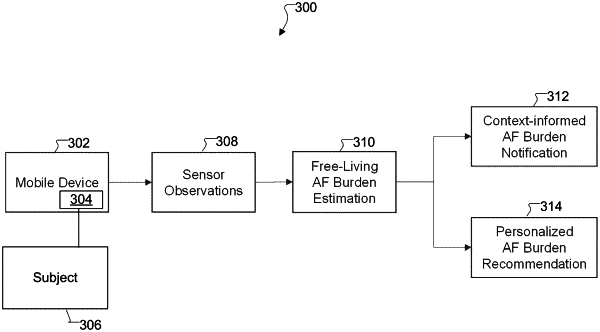| CPC A61B 5/361 (2021.01) [A61B 5/1118 (2013.01); A61B 5/339 (2021.01); A61B 5/486 (2013.01); A61B 5/6898 (2013.01); G16H 10/60 (2018.01); G16H 20/30 (2018.01); G16H 40/67 (2018.01); G16H 50/30 (2018.01); G16H 50/50 (2018.01); G16H 50/70 (2018.01)] | 20 Claims |

|
1. A method, comprising:
estimating, by a consumer electronic device, an atrial fibrillation (AF) burden of a subject based on multiple measurements passively collected by at least one sensor associated with the consumer electronic device while the subject is in a free-living environment;
outputting, by the consumer electronic device, an AF burden notification associated with the subject based on the estimated AF burden; and
outputting, by the consumer electronic device, an AF burden recommendation based on the estimated AF burden;
wherein estimating the AF burden comprises:
obtaining a first sequence of state values based on the multiple measurements collected by the at least one sensor, the first sequence of state values including past detected AF states and past detected normal sinus rhythm (NSR) states of the subject;
obtaining a transition probability matrix comprising values indicating probabilities of state transitions between an AF state and a NSR state;
obtaining an emission probability matrix comprising values indicating probabilities of one or more estimated AF states or one or more estimated NSR states arising from multiple observations; and
estimating a second sequence of state values based on the first sequence of state values, the transition probability matrix, and the emission probability matrix.
|
|
8. An electronic device comprising:
at least one memory configured to store instructions; and
at least one processor configured when executing the instructions to:
estimate an atrial fibrillation (AF) burden of a subject based on multiple measurements passively collected by at least one sensor associated with the electronic device while the subject is in a free-living environment;
output an AF burden notification associated with the subject based on the estimated AF burden; and
output an AF burden recommendation based on the estimated AF burden;
wherein the electronic device is a consumer electronic device; and
wherein, to estimate the AF burden, the at least one processor is configured to:
obtain a first sequence of state values based on the multiple measurements collected by the at least one sensor, the first sequence of state values including past detected AF states and past detected normal sinus rhythm (NSR) states of the subject;
obtain a transition probability matrix comprising values indicating probabilities of state transitions between an AF state and a NSR state;
obtain an emission probability matrix comprising values indicating probabilities of one or more estimated AF states or one or more estimated NSR states arising from multiple observations; and
estimate a second sequence of state values based on the first sequence of state values, the transition probability matrix, and the emission probability matrix.
|
|
15. A non-transitory computer readable medium containing computer readable program code that, when executed, causes at least one processor of an electronic device to:
estimate an atrial fibrillation (AF) burden of a subject based on multiple measurements passively collected by at least one sensor associated with the electronic device while the subject is in a free-living environment;
output an AF burden notification associated with the subject based on the estimated AF burden; and
output an AF burden recommendation based on the estimated AF burden;
wherein the electronic device is a consumer electronic device; and
wherein the computer readable program code that when executed causes the at least one processor to estimate the AF burden comprises:
computer readable program code that when executed causes the at least one processor to:
obtain a first sequence of state values based on the multiple measurements collected by the at least one sensor, the first sequence of state values including past detected AF states and past detected normal sinus rhythm (NSR) states of the subject;
obtain a transition probability matrix comprising values indicating probabilities of state transitions between an AF state and a NSR state;
obtain an emission probability matrix comprising values indicating probabilities of one or more estimated AF states or one or more estimated NSR states arising from multiple observations; and
estimate a second sequence of state values based on the first sequence of state values, the transition probability matrix, and the emission probability matrix.
|